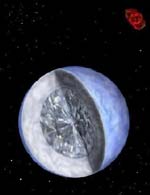Diamonds are relatively plentiful on Earth but DeBeer has a monopolistic control on the distribution and market....Nasty guys... Blood diamonds.
Astronomers Find a Huge Diamond in Space
When choosing a Valentine's Day gift for a wife or girlfriend, you can't go wrong with diamonds. If you really want to impress your favorite lady this Valentine's Day, get her the galaxy's largest diamond. But you'd better carry a deep wallet, because this 10 billion trillion trillion carat monster has a cost that's literally astronomical!
"You would need a jeweler's loupe the size of the Sun to grade this diamond!" says astronomer Travis Metcalfe (Harvard-Smithsonian Center for Astrophysics), who leads a team of researchers that discovered the giant gem. "Bill Gates and Donald Trump together couldn't begin to afford it."
When asked to estimate the value of the cosmic jewel, Ronald Winston, CEO of Harry Winston Inc., indicated that such a large diamond probably would depress the value of the market, stating, "Who knows? It may be a self-deflating prophecy because there is so much of it." He added, "It is definitely too big to wear!"
The newly discovered cosmic diamond is a chunk of crystallized carbon 50 light-years from the Earth in the constellation Centaurus. (A light-year is the distance light travels in a year, or about 6 trillion miles.) It is 2,500 miles across and weighs 5 million trillion trillion pounds, which translates to approximately 10 billion trillion trillion carats, or a one followed by 34 zeros.
"It's the mother of all diamonds!" says Metcalfe. "Some people refer to it as 'Lucy' in a tribute to the Beatles song 'Lucy In The Sky With Diamonds.'
The huge cosmic gem (technically known as BPM 37093) is actually a crystallized white dwarf. A white dwarf is the hot core of a star, left over after the star uses up its nuclear fuel and dies. It is made mostly of carbon and is coated by a thin layer of hydrogen and helium gases.
For more than four decades, astronomers have thought that the interiors of white dwarfs crystallized, but obtaining direct evidence became possible only recently.
"The hunt for the crystal core of this white dwarf has been like the search for the Lost Dutchman's Mine. It was thought to exist for decades, but only now has it been located," says co-author Michael Montgomery (University of Cambridge).
 http://www.universetoday.com/2004/02/13/astronomers-find-a-huge-diamond-in-space/
http://www.universetoday.com/2004/02/13/astronomers-find-a-huge-diamond-in-space/